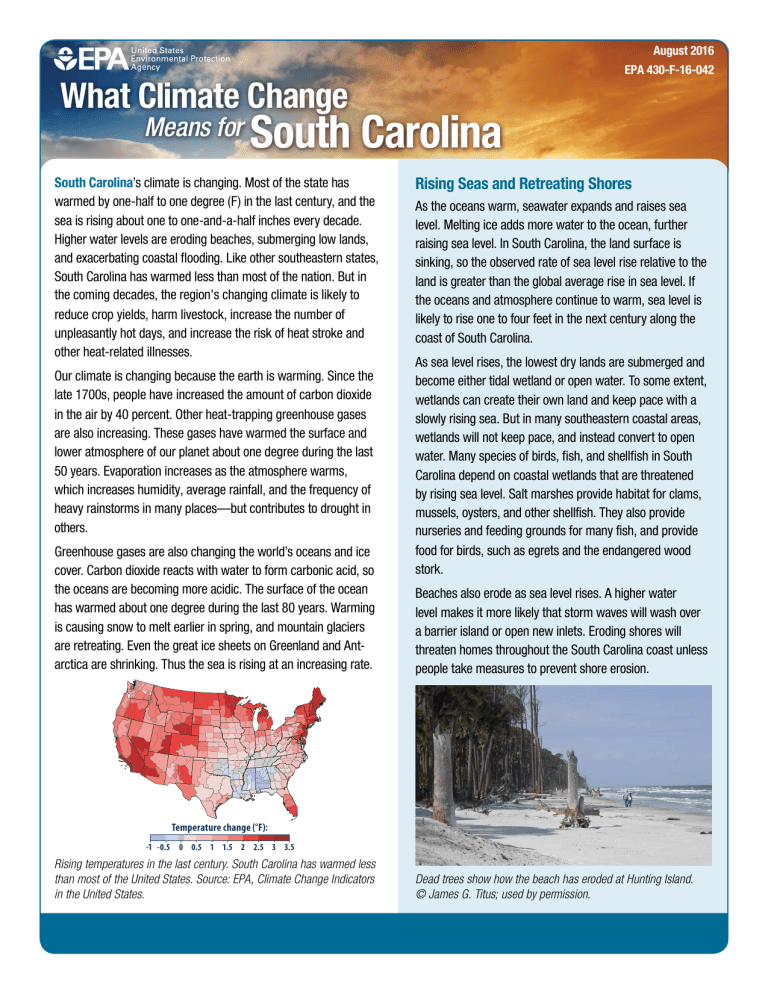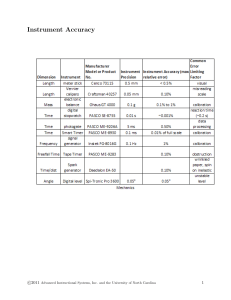
August 2016 What Climate Change Means for EPA 430-F-16-042 South Carolina South Carolina’s climate is changing. Most of the state has warmed by one-half to one degree (F) in the last century, and the sea is rising about one to one-and-a-half inches every decade. Higher water levels are eroding beaches, submerging low lands, and exacerbating coastal flooding. Like other southeastern states, South Carolina has warmed less than most of the nation. But in the coming decades, the region's changing climate is likely to reduce crop yields, harm livestock, increase the number of unpleasantly hot days, and increase the risk of heat stroke and other heat-related illnesses. Our climate is changing because the earth is warming. Since the late 1700s, people have increased the amount of carbon dioxide in the air by 40 percent. Other heat-trapping greenhouse gases are also increasing. These gases have warmed the surface and lower atmosphere of our planet about one degree during the last 50 years. Evaporation increases as the atmosphere warms, which increases humidity, average rainfall, and the frequency of heavy rainstorms in many places—but contributes to drought in others. Greenhouse gases are also changing the world’s oceans and ice cover. Carbon dioxide reacts with water to form carbonic acid, so the oceans are becoming more acidic. The surface of the ocean has warmed about one degree during the last 80 years. Warming is causing snow to melt earlier in spring, and mountain glaciers are retreating. Even the great ice sheets on Greenland and Antarctica are shrinking. Thus the sea is rising at an increasing rate. Rising Seas and Retreating Shores As the oceans warm, seawater expands and raises sea level. Melting ice adds more water to the ocean, further raising sea level. In South Carolina, the land surface is sinking, so the observed rate of sea level rise relative to the land is greater than the global average rise in sea level. If the oceans and atmosphere continue to warm, sea level is likely to rise one to four feet in the next century along the coast of South Carolina. As sea level rises, the lowest dry lands are submerged and become either tidal wetland or open water. To some extent, wetlands can create their own land and keep pace with a slowly rising sea. But in many southeastern coastal areas, wetlands will not keep pace, and instead convert to open water. Many species of birds, fish, and shellfish in South Carolina depend on coastal wetlands that are threatened by rising sea level. Salt marshes provide habitat for clams, mussels, oysters, and other shellfish. They also provide nurseries and feeding grounds for many fish, and provide food for birds, such as egrets and the endangered wood stork. Beaches also erode as sea level rises. A higher water level makes it more likely that storm waves will wash over a barrier island or open new inlets. Eroding shores will threaten homes throughout the South Carolina coast unless people take measures to prevent shore erosion. Temperature change (°F): -1 -0.5 0 0.5 1 1.5 2 2.5 3 3.5 Rising temperatures in the last century. South Carolina has warmed less than most of the United States. Source: EPA, Climate Change Indicators in the United States. Dead trees show how the beach has eroded at Hunting Island. © James G. Titus; used by permission. Storms, Homes, and Infrastructure Tropical storms and hurricanes have become more intense during the past 20 years. Although warming oceans provide these storms with more potential energy, scientists are not sure whether the recent intensification reflects a long-term trend. Nevertheless, hurricane wind speeds and rainfall rates are likely to increase as the climate continues to warm. Whether or not storms become more intense, coastal homes and infrastructure will flood more often as sea level rises, because storm surges will become higher as well. Rising sea level is likely to increase flood insurance rates, while more frequent storms could increase the deductible for wind damage in homeowner insurance policies. Charleston and the barrier islands are especially vulnerable to the impacts of storms and sea level rise. Changing the climate is also likely to increase inland flooding. Since 1958, the amount of precipitation during heavy rainstorms has increased by 27 percent in the Southeast, and the trend toward increasingly heavy rainstorms is likely to continue. effects of heat on cotton, soybeans, wheat, and peanuts— assuming that adequate water is available. More severe droughts, however, could cause crop failures. Higher temperatures are also likely to reduce livestock productivity, because heat stress disrupts the animals’ metabolism. Forests Higher temperatures and changes in rainfall are unlikely to substantially reduce forest cover in South Carolina, although the composition of trees in the forests may change. More droughts would reduce forest productivity, and climate change is also likely to increase the damage from insects and disease. But longer growing seasons and increased concentrations of carbon dioxide could more than offset the losses from those factors. Today forests cover two-thirds of the state. Loblolly pine trees dominate forests in most of the state, while oak, gum, and cypress trees are common in northeastern South Carolina; and oak and white pine are more common in the mountains. Changing the climate may alter the composition of forests throughout the state to more closely reflect the oak and white pine forests found today in the mountains. Human Health As sea level rises, Charleston’s streets are increasingly prone to flooding at high tide. Credit: NOAA. Agriculture Changing the climate will have both harmful and beneficial effects on farming. During the next few decades, hotter summers are likely to reduce yields of corn. But higher concentrations of atmospheric carbon dioxide increase crop yields, and that fertilizing effect is likely to offset the harmful Hot days can be unhealthy—even dangerous. Certain people are especially vulnerable, including children, the elderly, the sick, and the poor. High air temperatures can cause heat stroke and dehydration and affect people’s cardiovascular and nervous systems. Seventy years from now, temperatures are likely to rise above 95°F approximately 30 to 60 days per year in much of South Carolina, compared with about 15 such days today. Warmer air can also increase the formation of ground-level ozone, a key component of smog. Ozone has a variety of health effects, aggravates lung diseases such as asthma, and increases the risk of premature death from heart or lung disease. EPA and the South Carolina Department of Health and Environmental Control have been working to reduce ozone concentrations. As the climate changes, continued progress toward clean air will be more difficult. The sources of information about climate and the impacts of climate change in this publication are: the national climate assessments by the U.S. Global Change Research Program, synthesis and assessment products by the U.S. Climate Change Science Program, assessment reports by the Intergovernmental Panel on Climate Change, and EPA’s Climate Change Indicators in the United States. Mention of a particular season, location, species, or any other aspect of an impact does not imply anything about the likelihood or importance of aspects that are not mentioned. For more information about climate change science, impacts, responses, and what you can do, visit EPA’s Climate Change website at www.epa.gov/climatechange.



